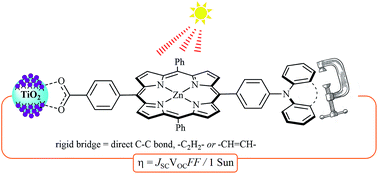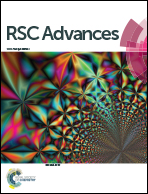Rigid triarylamine donor–π–acceptor porphyrin dyes and their application in dye-sensitized solar cells†
Abstract
Three donor–π–acceptor porphyrin dyes bearing a variety of rigid triarylamine donor groups were synthesized for application as photosensitizers in TiO2 based dye-sensitized solar cells (DSSCs). Compared with the “naked” porphyrin ZnP, i.e. having no triarylamine moiety, broadened and red-shifted spectral features were exhibited by the triaylamine porphyrin sensitizers ISB-ZnP, CZ-ZnP, and IDB-ZnP where ISB = 5-phenyliminostilbene, CZ = 5-phenylcarbazole, and IDB = 5-phenyliminodibenzyl. Percentage power conversion efficiencies (η) and incident photon-to-current conversion efficiencies (%IPCE) in DSSC devices show the trend ISB-ZnP < ZnP < CZ-ZnP < IDB-ZnP. Inferior performance of the ISB-ZnP dye is attributed to its weaker adsorption to the TiO2 film, which is roughly half that of ZnP. In contrast, introduction of the CZ and IDB electron donors is demonstrated to promote a better performance than the “naked” ZnP porphyrin. The best performance was observed for the IDB-ZnP device reaching a power conversion efficiency of η = 3.62% under AM 1.5 irradiation conditions with a corresponding %IPCE maximizing at 48% for both Soret band (450 nm) and Q band (570 nm) photoexcitation.


 Please wait while we load your content...
Please wait while we load your content...